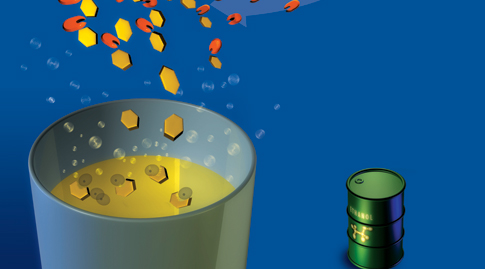

Scientists have found a way to take everyone’s least favorite greenhouse gas, carbon dioxide, and mix it with water to create alcohol.
A research team at Oak Ridge National Laboratory in Tennessee developed a way to convert carbon dioxide into ethanol—and they did it by accident. Originally, they were hoping to convert carbon dioxide that had been dissolved in water to methanol, a chemical released naturally by volcanic gases and microbes, which can cause blindness in humans if ingested.
But instead of methanol, they discovered they had ethanol, a primary component of gin and also a potential fuel source. Surprised, the team realized that not only was their new material converting the carbon dioxide to ethanol, it needed very little outside support.
The material is a small chip—about a square centimeter in size—covered in spikes, each just a few atoms across. Each spike is constructed out of nitrogen with a carbon sheath and a small sphere of copper embedded in each tip. The chip is dipped into water and carbon dioxide is bubbled in. The copper acts as a small lightning rod, attracting electricity and driving the first steps of the conversion of the carbon dioxide and water into ethanol, before the molecules move to the carbon sheath to finish the process.
Adam Rondinone, the lead researcher, says it’s like pushing combustion backwards—normally ethanol can burn with oxygen to produce carbon dioxide and water, as well as energy. But they’ve managed to reverse the process, supplying carbon dioxide and water, supplying it with electricity, and ending up with ethanol.

The new nano-structured material allowed the researchers to use widely available materials like copper instead of more expensive options like platinum. In the past, this has hampered the ability to manufacture a material like this at larger scales.
The team hopes that their material, because it’s made from more easily available components, will be able to scale up successfully.
Even though the process probably won’t help much with carbon dioxide in the atmosphere—Rondinone says it would be too energetically costly—he believes there is another way for this process to help meet energy demands.
Rondinone sees an opportunity to help with intermittent power sources like wind and solar. By capturing excess electricity generated by the process and storing it in the form of ethanol, it could be burned later when the wind turbines aren’t spinning or the sun isn’t shining.
Don’t plan on seeing a new Oak Ridge National Laboratory luxury brand of 130 proof liquor on the shelves anytime soon though. Although Rondinone says the ethanol is just like the ethanol you drink, it also contains trace quantities of formate, which is toxic to humans. He cautions, “I would not advise people to drink it without further purification.”
Correction: This article has been updated to correct the first name of the lead author.
